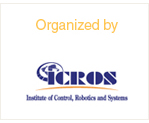 Plenary SessionICCAS2016 > Program > Plenary Session
Plenary SessionICCAS2016 > Program > Plenary Session

Plenary Session 1: October 17 (MON), 10:50~11:50, Room 202
Satoshi Tadokoro
Professor, Graduate School of Information Sciences Tohoku University, Japan
President, International Rescue System Institute
Challenge of Disaster Robotics
Abstract: The Great East Japan Earthquake was the first disaster in the world history where a number of robotic systems were used for disaster response and recovery. It is expected that robotics becomes an essential solution in the near future for reducing risk of disasters by improving preparedness, for minimizing damage at emergency response, and for accelerating recovery to return to normal. In this plenary speech, main use and conditions of disaster robotics is presented at first. It explains the state of art of disaster robotics by introducing some examples of applications and development of robots by the author's group with showing potential effectiveness in the future. It analyzes the currently existing gaps in three categories: technology, society and industry. Finally, it introduces efforts for promoting the social implementation of robotics as well as expected contributions from the area of robotics.
Biography: Satoshi Tadokoro graduated from the University of Tokyo in 1984. He became an associate professor of Kobe University in 1993-2005, and is a professor of Tohoku University since 2005, a vice dean in 2014, and a research professor since 2014. He is a president of International Rescue System Institute since 2002 and IEEE RAS President in 2016-2017. He served as a project manager of MEXT DDT Project on rescue robotics in 2002-2007 having contribution of more than 100 professors nationwide, and of a NEDO project that developed a rescue robot Quince, which was used in nuclear reactor buildings of the Fukushima-Daiichi Nuclear Power Plant Accident as the first Japanese robot. He is a project manager of Japan Cabinet Office ImPACT Tough Robotics Challenge Project in 2014-18. IEEE Fellow, RSJ Fellow, JSME Fellow, and SICE Fellow.
Biography: Satoshi Tadokoro graduated from the University of Tokyo in 1984. He became an associate professor of Kobe University in 1993-2005, and is a professor of Tohoku University since 2005, a vice dean in 2014, and a research professor since 2014. He is a president of International Rescue System Institute since 2002 and IEEE RAS President in 2016-2017. He served as a project manager of MEXT DDT Project on rescue robotics in 2002-2007 having contribution of more than 100 professors nationwide, and of a NEDO project that developed a rescue robot Quince, which was used in nuclear reactor buildings of the Fukushima-Daiichi Nuclear Power Plant Accident as the first Japanese robot. He is a project manager of Japan Cabinet Office ImPACT Tough Robotics Challenge Project in 2014-18. IEEE Fellow, RSJ Fellow, JSME Fellow, and SICE Fellow.

Plenary Session 2: October 17 (MON), 14:40~15:40, Room 202
Andrew Schwartz
Professor, Neurobiology University of Pittsburgh, USA
Recent Progress toward a high-performance
Neural Prosthesis
Neural Prosthesis
Abstract: A better understanding neural population function would be an important advance in systems neuroscience. The change in emphasis from the single neuron to the neural ensemble has made it possible to extract high-fidelity information about movements that will occur in the near future. Neurons encode many parameters simultaneously. Although the correlation between firing rate and any single parameter may be weak, extraction methods based on multiple neurons are capable of generating a faithful representation, or decoding of intended movement. The realization that useful information is embedded in the population has spawned the current success of brain-controlled interfaces. We have been gradually increasing the degrees of freedom (DOF) that a subject can control through the interface. Our early work showed that 3-dimensions could be controlled in a virtual reality task. We then demonstrated control of an anthropomorphic physical device with 4 DOF in a self-feeding task. Currently, monkeys in our laboratory are using this interface to control a very realistic, prosthetic arm with a wrist and hand to grasp objects in different locations and orientations. This technology has now been extended has been extended to a paralyzed patient who cannot move any part of her body below her neck. Based on our laboratory work and using a high-performance "modular prosthetic limb" she has been able to control 10 degrees-of-freedom simultaneously. The control of this artificial limb is intuitive and the movements are coordinated and graceful, closely resembling natural arm and hand movement. This subject has been able to perform tasks of daily living--reaching to, grasping, and manipulating objects as well as performing spontaneous acts such as self-feeding. Current work in a second subject who was implanted with additional stimulating electrodes in the finger region of his sensory cortex is progressing. With this addition, we expect to provide tactile feedback to the subject from the prosthetic fingers as he grasps objects and develops dexterity with the device.
Biography: Dr. Schwartz received his Ph.D. in Physiology from the University of Minnesota in 1984. He then went on to a postdoctoral fellowship with Dr. Apostolos Georgopoulos, who was developing the concept of directional tuning and population-based movement representation in the motor cortex. After building research programs in Phoenix and San Diego, he moved to the University of Pittsburgh in 2002. Schwartz' research is centered on the exploration of cortical signals generated during volitional arm movements. This effort showed that a high-fidelity representation of movement intention could be decoded from the motor cortex and enabled technology now being used by paralyzed subjects to operate a high-performance prosthetic arm and hand.
Biography: Dr. Schwartz received his Ph.D. in Physiology from the University of Minnesota in 1984. He then went on to a postdoctoral fellowship with Dr. Apostolos Georgopoulos, who was developing the concept of directional tuning and population-based movement representation in the motor cortex. After building research programs in Phoenix and San Diego, he moved to the University of Pittsburgh in 2002. Schwartz' research is centered on the exploration of cortical signals generated during volitional arm movements. This effort showed that a high-fidelity representation of movement intention could be decoded from the motor cortex and enabled technology now being used by paralyzed subjects to operate a high-performance prosthetic arm and hand.

Plenary Session 3: October 17 (MON), 15:40~16:40, Room 202
James Ashton-Miller
Professor, Mechanical Engineering,Biomedical Engineering and Internal Medicine
University of Michigan, USA
On Human Balance, Locomotion, and Fall-Related Injuries
Abstract: Unintentional injuries cost our countries hundreds of millions of dollars each year. This lecture focuses on what the mechanisms of unintentional injuries can tell us about how the brain controls the musculoskeletal system under time critical situations, the strategies that it adopts to try to prevent injury under these conditions, and why it sometimes fails. We shall explore how rapidly humans can respond to stimuli of various types under conditions of increasing motivation or to protect themselves under increasing threat levels. Are there sex and age differences in these responses, how marked are they, and what factors are important? Knowing the answers to questions like these is important when designing control systems with which a human has to interact under time-critical conditions and when designing systems for monitoring human behavior and performance anywhere whether at home, at work, in sports or when ill.
Biography: Associate Vice President for Research, University of Michigan, and Albert Schultz Collegiate Research Professor and Distinguished Research Scientist, Departments of Mechanical Engineering, Biomedical Engineering and Internal Medicine, and the School of Kinesiology, University of Michigan, Ann Arbor.
Dr. Ashton-Miller directs the Biomechanics Research Laboratory at the University of Michigan. He uses theoretical and experimental approaches to understand the biomechanics of unintentional injuries across the life span so they and their sequelae can be better prevented. Current research includes sports-related anterior cruciate ligament (ACL) injuries in the knee, fall-related injuries, and maternal birth-related pelvic floor injuries and their sequelae (incontinence and prolapse). He has authored over 250 scientific articles, several patents and graduated 30 doctoral students. He is a past-President of the American Society of Biomechanics (ASB), a fellow of ASME, AIMBE, ASB and GSA, and winner of the 2009 ASB Giovanni Borelli award and the 2015 ASME H.R. Lissner Medal for contributions in biomechanics and bioengineering, and the 2016 Kappa Delta award from the Orthopedic Research Society and American Academy of Orthopedic Surgeons for his ACL research. Dr. Ashton-Miller received his B.Sc (Hons) from Newcastle University, U.K., his MSME from M.I.T., and Ph.D. from the University of Oslo, Norway.
Biography: Associate Vice President for Research, University of Michigan, and Albert Schultz Collegiate Research Professor and Distinguished Research Scientist, Departments of Mechanical Engineering, Biomedical Engineering and Internal Medicine, and the School of Kinesiology, University of Michigan, Ann Arbor.
Dr. Ashton-Miller directs the Biomechanics Research Laboratory at the University of Michigan. He uses theoretical and experimental approaches to understand the biomechanics of unintentional injuries across the life span so they and their sequelae can be better prevented. Current research includes sports-related anterior cruciate ligament (ACL) injuries in the knee, fall-related injuries, and maternal birth-related pelvic floor injuries and their sequelae (incontinence and prolapse). He has authored over 250 scientific articles, several patents and graduated 30 doctoral students. He is a past-President of the American Society of Biomechanics (ASB), a fellow of ASME, AIMBE, ASB and GSA, and winner of the 2009 ASB Giovanni Borelli award and the 2015 ASME H.R. Lissner Medal for contributions in biomechanics and bioengineering, and the 2016 Kappa Delta award from the Orthopedic Research Society and American Academy of Orthopedic Surgeons for his ACL research. Dr. Ashton-Miller received his B.Sc (Hons) from Newcastle University, U.K., his MSME from M.I.T., and Ph.D. from the University of Oslo, Norway.

Plenary Session 4: October 18 (TUE), 10:50~11:50, Room 202
Song K Choi
Assistant Dean/Interim Associate Dean/Professor,College of Engineering,
University of Hawaii at Manoa
Robot Autonomy: Are Robots the “New” Immigrants?
Abstract: Advances in robots and associated technologies are outpacing humans in many sectors of our every day life, from simple domestic chores to education to healthcare to agriculture/manufacturing to search and rescue to simple entertainment and many folds beyond… There have been great concerns that robots and technology will “replace” the human workforce in our workplace, both far and wide. During previous acceleration in technology, for example the industrial revolution, many jobs were eliminated; however, multiple jobs were created to accommodate the change. As new machines become more ‘autonomous’ or ‘self-correcting’, fewer replacement jobs may be necessary. The overall effect of ‘autonomy’ for machines could be devastating to our economy, society, and ‘way of life’; but with changes, opportunities will always arise. What is our current level of autonomy in unmanned systems, vehicles, and beyond? What are some of the associated research at the University of Hawaii at Manoa?
A brief presentation will also be made to highlight some of the current state of the art research at the University of Hawaii at Manoa.
Biography: Dr. Song K. Choi received his BS, MS, & PhD in Mechanical Engineering from Worcester Polytechnic Institute, Carnegie Mellon University, and University of Hawaii at Manoa, respectively. His specializations are in dynamics, controls, and robotics with emphasis on unmanned systems, automatic control systems, autonomous vehicle design, novel sensor systems, alternative/renewable power sources, process automation, and graphic monitoring systems for autonomous unmanned vehicles in the hazardous, aerial, and underwater environments. He returned to Hawaii in 1991 and has been a professor and researcher in the Autonomous Systems Engineering, Department of Mechanical Engineering, and has published numerous, refereed papers in his areas of expertise. He has received numerous grants and awards from federal, state, and county agencies, non-profit groups, universities, societies, and industry for his research, education, and community service. He has held various positions in the College including assistant dean, interim associate dean, and acting dean for the College of Engineering since 2004 and has been working with various primary, middle, and high schools in the State in promoting STEM education through robotics. He is also credited as one of the forefathers of scholarstic robotics (K-12 grades) in Hawaii. His other interests lie in the areas of innovation & entrepreneurship and international business; and he is a co-founder of the Marine Autonomous Systems Engineering, Inc., a Hawaii-based spin-off company specializing in autonomous marine and robotic technologies and unique academic solutions. He is an active member of engineering and academic societies, and serves as a board member on multiple academic, engineering, technology, business, education, and philantropic organizations.
A brief presentation will also be made to highlight some of the current state of the art research at the University of Hawaii at Manoa.
Biography: Dr. Song K. Choi received his BS, MS, & PhD in Mechanical Engineering from Worcester Polytechnic Institute, Carnegie Mellon University, and University of Hawaii at Manoa, respectively. His specializations are in dynamics, controls, and robotics with emphasis on unmanned systems, automatic control systems, autonomous vehicle design, novel sensor systems, alternative/renewable power sources, process automation, and graphic monitoring systems for autonomous unmanned vehicles in the hazardous, aerial, and underwater environments. He returned to Hawaii in 1991 and has been a professor and researcher in the Autonomous Systems Engineering, Department of Mechanical Engineering, and has published numerous, refereed papers in his areas of expertise. He has received numerous grants and awards from federal, state, and county agencies, non-profit groups, universities, societies, and industry for his research, education, and community service. He has held various positions in the College including assistant dean, interim associate dean, and acting dean for the College of Engineering since 2004 and has been working with various primary, middle, and high schools in the State in promoting STEM education through robotics. He is also credited as one of the forefathers of scholarstic robotics (K-12 grades) in Hawaii. His other interests lie in the areas of innovation & entrepreneurship and international business; and he is a co-founder of the Marine Autonomous Systems Engineering, Inc., a Hawaii-based spin-off company specializing in autonomous marine and robotic technologies and unique academic solutions. He is an active member of engineering and academic societies, and serves as a board member on multiple academic, engineering, technology, business, education, and philantropic organizations.

Plenary Session 5: October 18 (TUE), 14:40~15:40, Room 202
Maria Prandini
Associate Professor, Systems and Control Dipartimento di Elettronica, Informazione e Bioingegneria
Politecnico di Milano
Milano, Italy
A big-data approach to decision making under uncertainty
Abstract: Many design problems in systems and control can be formulated as optimization problems, where the decision variables are chosen so as to optimize performance while possibly accounting for constraints. This task is not easy in general, and it becomes even more challenging in the presence of uncertainty, which is typically the case in practical problems where models are partially unknown and disturbances are affecting the system. Traditional methods for decision making are either deterministic in that they neglect uncertainty and assume an accurate knowledge of both the underlying system and the environment, or worst-case in that they set the decision variables so as to achieve some guaranteed level of performance for all possible uncertainty instances.
Motivated by emerging applications from the energy systems domain, we shall discuss a different, probabilistic perspective where design is robustified against uncertainty while accounting for the actual likelihood of the different uncertainty instances to occur. Both centralized and distributed algorithms that allow to take decisions on the basis of historical data, possibly available only locally, will be presented. This data-driven approach looks promising and is synergic with the current ``big-data'' trend , where the increasing digitalization of various processes and the advancements in communication, sensor technology, and data fusion lead to a huge amount of, often easily accessible, data.
Biography: Maria Prandini received her laurea degree in Electrical Engineering (summa cum laude) from Politecnico di Milano (1994) and her Ph.D. degree in Information Technology from Universita degli Studi di Brescia, Italy (1998). From 1998 to 2000 she was a postdoctoral researcher at the Department of Electrical Engineering and Computer Sciences, University of California at Berkeley. She also held visiting positions at Delft University of Technology (1998), Cambridge University (2000), University of California at Berkeley (2005), and Swiss Federal Institute of Technology Zurich (2006). In 2002, she started as an assistant professor in systems and control at Politecnico di Milano, where she is currently an associate professor.
Her research interests include stochastic hybrid systems, randomized algorithms, constrained control, system abstraction and verification, nonlinear identification, distributed optimization, and the application of control theory to air traffic management and energy systems.
She was in the editorial boards of IEEE Transactions on Automatic Control, IEEE Transactions on Control Systems Technology, European Journal of Control, and Nonlinear Analysis: Hybrid Systems. She currently serves as associated editor in the Cyber Physical Systems editorial board. Since 2008, she is member of the IFAC Technical Committee on Discrete Event and Hybrid Systems.
From 2013 to 2105, she was editor for Electronic Publications of the IEEE Control Systems Society (CSS), being, among other things, responsible for the E-Letter on Systems, Control, and Signal Processing. She was elected member of the IEEE CSS Board of Governors in May 2014 for a triennium starting from January 2015. Since January 2016 she is CSS Vice-President for Conference Activities.
Motivated by emerging applications from the energy systems domain, we shall discuss a different, probabilistic perspective where design is robustified against uncertainty while accounting for the actual likelihood of the different uncertainty instances to occur. Both centralized and distributed algorithms that allow to take decisions on the basis of historical data, possibly available only locally, will be presented. This data-driven approach looks promising and is synergic with the current ``big-data'' trend , where the increasing digitalization of various processes and the advancements in communication, sensor technology, and data fusion lead to a huge amount of, often easily accessible, data.
Biography: Maria Prandini received her laurea degree in Electrical Engineering (summa cum laude) from Politecnico di Milano (1994) and her Ph.D. degree in Information Technology from Universita degli Studi di Brescia, Italy (1998). From 1998 to 2000 she was a postdoctoral researcher at the Department of Electrical Engineering and Computer Sciences, University of California at Berkeley. She also held visiting positions at Delft University of Technology (1998), Cambridge University (2000), University of California at Berkeley (2005), and Swiss Federal Institute of Technology Zurich (2006). In 2002, she started as an assistant professor in systems and control at Politecnico di Milano, where she is currently an associate professor.
Her research interests include stochastic hybrid systems, randomized algorithms, constrained control, system abstraction and verification, nonlinear identification, distributed optimization, and the application of control theory to air traffic management and energy systems.
She was in the editorial boards of IEEE Transactions on Automatic Control, IEEE Transactions on Control Systems Technology, European Journal of Control, and Nonlinear Analysis: Hybrid Systems. She currently serves as associated editor in the Cyber Physical Systems editorial board. Since 2008, she is member of the IFAC Technical Committee on Discrete Event and Hybrid Systems.
From 2013 to 2105, she was editor for Electronic Publications of the IEEE Control Systems Society (CSS), being, among other things, responsible for the E-Letter on Systems, Control, and Signal Processing. She was elected member of the IEEE CSS Board of Governors in May 2014 for a triennium starting from January 2015. Since January 2016 she is CSS Vice-President for Conference Activities.

Plenary Session 6: October 18 (TUE), 15:40~16:40, Room 202
Okyay Kaynak
Professor, Bogazici University, Turkey & Harbin Institute of Technology (HIT), China
CAS in 21st Century
Abstract: The presentation considers the status of CAS, i.e. Control, Automation and Systems (the main areas of ICCAS 2016) in the information age and a discussion is given on how the boundaries that separate it from other technologies are eroding. The state-of-art reached in CAS in the form of intelligent systems is overviewed with examples from different industries and a perspective on the future is given. An assessment of the past is presented, discussing the profound technological changes that have taken place during the last 2 decades, especially the changes observed in manufacturing industries. The emerging paradigms of big data and cyber physical systems (CPS), supported by new disruptive advances both on software and hardware side, as well as the cross-fertilization of concepts and the amalgamation of information, communication and control technology driven approaches are pointed out to. The role of deep learning in big data and CPS is discussed. This is followed by a look at the evolution of the manufacturing paradigms, with particular emphasis on the Fourth Industrial Revolution, one of the aims of which is to introduce higher levels MIQ in devices. The talk closes with a consideration of the possible research directions in mechatronics and robotics as the driving forces behind intelligent systems.
Biography: Okyay Kaynak received the B.Sc. degree with first class honors and Ph.D. degrees in electronic and electrical engineering from the University of Birmingham, UK, in 1969 and 1972 respectively.
From 1972 to 1979, he held various positions within the industry. In 1979, he joined the Department of Electrical and Electronics Engineering, Bogazici University, Istanbul, Turkey, where he is presently a Full Professor holding the UNESCO Chair on Mechatronics. He is also a 1000 People Plan Professor at Harbin Institute of Technology, Harbin, China. He has hold long-term (near to or more than a year) Visiting Professor/Scholar positions at various institutions in Japan, Germany, U.S., Singapore and China. His current research interests are in the fields of intelligent control and mechatronics. He has authored three books, edited five and authored or co-authored more than 400 papers that have appeared in various journals and conference proceedings.
Dr. Kaynak is a fellow of IEEE. Currently he is the Editor-in-Chief of IEEE/ASME Transactions on Mechatronics. Additionally, he is on the Editorial or Advisory Boards of a number of scholarly journals.
Dr. Kaynak is active in international organizations, has served on many committees of IEEE and was the president of IEEE Industrial Electronics Society during 2002-2003.
Biography: Okyay Kaynak received the B.Sc. degree with first class honors and Ph.D. degrees in electronic and electrical engineering from the University of Birmingham, UK, in 1969 and 1972 respectively.
From 1972 to 1979, he held various positions within the industry. In 1979, he joined the Department of Electrical and Electronics Engineering, Bogazici University, Istanbul, Turkey, where he is presently a Full Professor holding the UNESCO Chair on Mechatronics. He is also a 1000 People Plan Professor at Harbin Institute of Technology, Harbin, China. He has hold long-term (near to or more than a year) Visiting Professor/Scholar positions at various institutions in Japan, Germany, U.S., Singapore and China. His current research interests are in the fields of intelligent control and mechatronics. He has authored three books, edited five and authored or co-authored more than 400 papers that have appeared in various journals and conference proceedings.
Dr. Kaynak is a fellow of IEEE. Currently he is the Editor-in-Chief of IEEE/ASME Transactions on Mechatronics. Additionally, he is on the Editorial or Advisory Boards of a number of scholarly journals.
Dr. Kaynak is active in international organizations, has served on many committees of IEEE and was the president of IEEE Industrial Electronics Society during 2002-2003.

Plenary Session 7: October 19 (WED), 10:50~11:50, Room 202
Sangchul Won
Professor, Department of Electrical Engineering and GraduateInstitute of Ferrous Technology
Pohang University of Science & Technology, Korea
Inspection Technologies in a Steel Manufacturing Process
Abstract: In order to improve the quality of steel product, it is very important to inspect the product in a steel manufacturing process. In this talk, we introduce the automated inspection technologies to manage the quality of steel in the manufacturing process.
One of them is the surface defect detection for hot wire rod, hot slab, and plate. The design difficulties of the surface defect detection system are high temperature, noisy scales on their surface, high production speed. To overcome these problems, we use state-of-art illumination technology using dual lighting, and sophisticated image processing algorithms such as wavelet transform. Another inspection technology to introduce is inner defect detection for the cold rolled strip. Inner defects of steel strip for automobile include lamination and inclusion. The developed inspection system is based on the magnetic flux leakage method. These inspection systems are proved to be effective at a real production line, and contributed to improve the quality of steel products.
Biography: Prof. Sangchul Won received the B.S. and M.S. degrees from Seoul National University, Seoul, Korea, in 1974 and 1976, respectively, and the Ph.D. degree in Electrical Engineering from the University of Iowa, Iowa City, USA in 1985. He was a Visiting Assistant Professor at the University of Iowa, in 1985, and from 1985 to 1987, he was an Assistant Professor at University of New Haven. He was a visiting professor at the Helsinki University of Technology, Finland in 2005, at Osaka University, Japan in 2009. He is currently a professor in the Department of Electrical Engineering and Graduate Institute of Ferrous Technology (GIFT), Pohang University of Science and Technology (POSTECH), Korea, where he is also director of the Steel Processing Automation Research Center (SPARC). He served as a chairman of the IFAC MMM Technical Committee in 2002-2008 and he is a member of IFAC Publication Committee. He also served as the President of ICROS, Korea in 2011. He was the President of the Asian Control Association (ACA) in 2014-2015. He is an Associate Editor of the IEEE Transactions on Industrial Electronics. He received several awards including a Korean Presidential Medal in 1994, ICASE Academic Award, 2002, and received ICCAS Best Paper Award from the Minister of Knowledge and Economy. He published more than 70 international SCI journal papers and 140 international conference papers His research interests include time delay systems, control systems with uncertainties, robot control and steel making process control and automation.
Biography: Prof. Sangchul Won received the B.S. and M.S. degrees from Seoul National University, Seoul, Korea, in 1974 and 1976, respectively, and the Ph.D. degree in Electrical Engineering from the University of Iowa, Iowa City, USA in 1985. He was a Visiting Assistant Professor at the University of Iowa, in 1985, and from 1985 to 1987, he was an Assistant Professor at University of New Haven. He was a visiting professor at the Helsinki University of Technology, Finland in 2005, at Osaka University, Japan in 2009. He is currently a professor in the Department of Electrical Engineering and Graduate Institute of Ferrous Technology (GIFT), Pohang University of Science and Technology (POSTECH), Korea, where he is also director of the Steel Processing Automation Research Center (SPARC). He served as a chairman of the IFAC MMM Technical Committee in 2002-2008 and he is a member of IFAC Publication Committee. He also served as the President of ICROS, Korea in 2011. He was the President of the Asian Control Association (ACA) in 2014-2015. He is an Associate Editor of the IEEE Transactions on Industrial Electronics. He received several awards including a Korean Presidential Medal in 1994, ICASE Academic Award, 2002, and received ICCAS Best Paper Award from the Minister of Knowledge and Economy. He published more than 70 international SCI journal papers and 140 international conference papers His research interests include time delay systems, control systems with uncertainties, robot control and steel making process control and automation.









